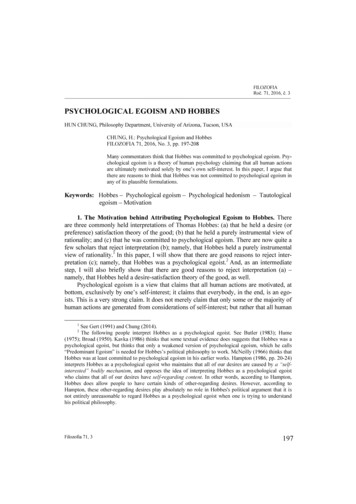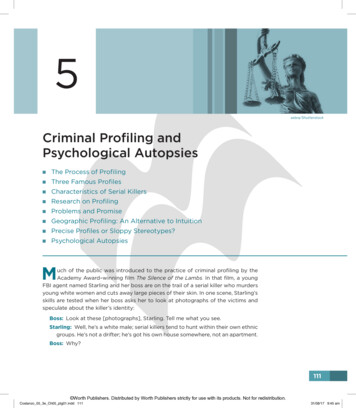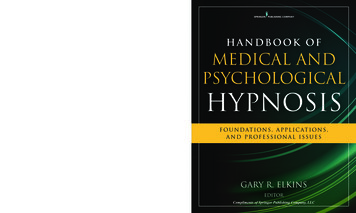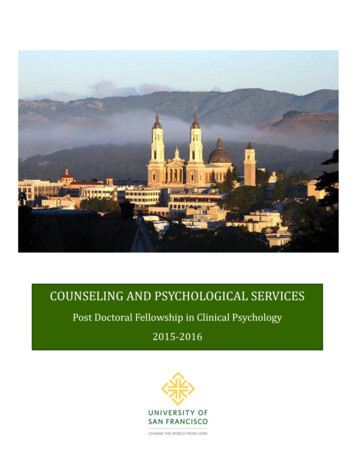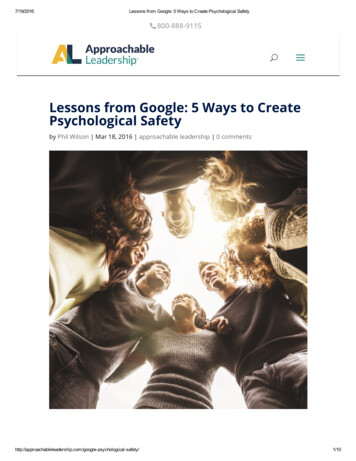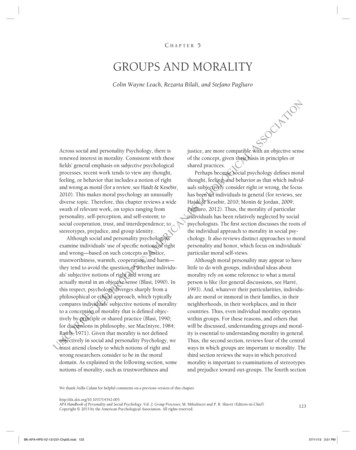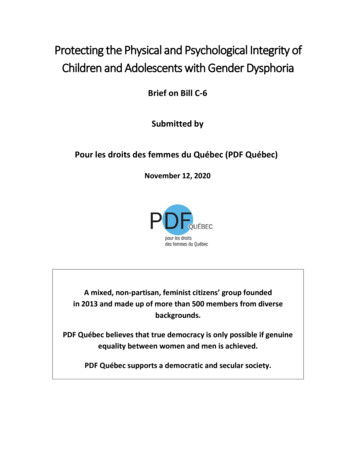
Transcription
Protecting the Physical and Psychological Integrity ofChildren and Adolescents with Gender DysphoriaBrief on Bill C-6Submitted byPour les droits des femmes du Québec (PDF Québec)November 12, 2020A mixed, non-partisan, feminist citizens’ group foundedin 2013 and made up of more than 500 members from diversebackgrounds.PDF Québec believes that true democracy is only possible if genuineequality between women and men is achieved.PDF Québec supports a democratic and secular society.
2Written byGhislaine GendronAnalyst and Head of PDF Québec’s committee on gender identityMichèle SiroisAnthropologist and Acting Vice-President of PDF QuébecWith the invaluable help of the members of PDF Québec’s board ofdirectorsThe authors would like to thank all those who assisted them.
3ContentsSummary . 4Introduction . 51. The dubious conflation of sexual orientation and gender dysphoria . 61.1 Sexual orientation . 61.2 Gender identity and gender dysphoria . 62. Lack of consensus on diagnosis and treatment . 72.1 The cautious exploratory psychotherapy approach . 82.2 The “affirmative” or “affirmation-based” therapy approach . 93. Children’s ability to consent to invasive treatment . 93.1 The effects of hormone blockers . 103.2 Cross-sex hormone administration . 114. Definition and interpretation of “conversion therapy” . 115. Lessons learned from foreign governments: Policy mistakes and reversals . 125.1 Sweden. 125.2 United Kingdom . 13Conclusion and recommendations . 13List of recommendations . 14
4SummaryOn October 1, 2020, the federal government introduced Bill C-6: An Act to amend the Criminal Code(conversion therapy) in the House of Commons. This bill amends the Criminal Code to prohibitpractising or advertising conversion therapy.The legislative summary of Bill C-6 rigorously documents the history and scientific evidence regarding“conversion therapy,” or sexual orientation change efforts (SOCE). Pour les Droits des Femmes duQuébec (PDF Québec) fully supports these findings and the goal of banning these therapies throughdeterrents. Homosexuality is not a disease that must be “treated” in order to change a person’s sexualorientation.However, Bill C-6 fails to highlight the evidence supporting the existence of conversion therapy to“change a person’s gender identity to cisgender” (to use the bill’s wording). It also fails to definespecifically what these conversion “efforts” would consist of.In the legislative summary of Bill C-6, the government merely refers to an article in the CanadianJournal of Psychiatry, in which the author states that there is no evidence about the prevalence of“conversion therapy” for transgender people in Canada. 1The author does not, however, define or describe “conversion therapy” for transgender people anduses the terms “gender” and “sex” interchangeably, as if they were synonyms. He then applies hisfindings about conversion therapy for sexual orientation to conversion therapy for transgenderism.The author, like the government, makes no reference to gender dysphoria (GD) in children, whichcauses suffering for which they seek therapy. Unlike homosexuality, GD is a mental health diagnosisthat often requires treatment, particularly in children and adolescents.The government has a responsibility to children and adolescents with genderdysphoria.The suffering of these vulnerable individuals compels us to take care of them,and Bill C-6 misses the mark.1Salway, T., et al., “Prevalence of Exposure to Sexual Orientation Change Efforts and Associated SociodemographicCharacteristics and Psychosocial Health Outcomes among Canadian Sexual Minority Men,” Canadian Journal ofPsychiatry, January 26, 2020, NVG8XR/full.
5IntroductionOn September 12, 2019, PDF Québec received an email from a young woman asking for help. We wouldlike to share an excerpt with the committee.My name is Sarah, and I’m a 19-year-old woman who was maimed by an inadequatetreatment for gender dysphoria when I was a teenager. 2 I could not provide informedconsent for this treatment because I was suffering from severe mental health problemsat the time. As you are probably aware, underage girls who are uncomfortable withtheir bodies (a normal discomfort, considering hypersexualization and the repercussionsof being perceived as a girl or woman) are offered hormones and surgery.One year after I stopped taking hormones, I became pregnant. I won’t be able tobreastfeed because I received an unnecessary mastectomy. I know that I’m not theonly one to have detransitioned, because there was a Radio-Canada article on thesubject. Sarah, now 20, shared her story and her suffering with us. The “affirmative therapy” (see section 2.2) shereceived has given her a deep voice that she finds difficult to come to terms with. She recently gave birthto a baby girl whom she cannot breastfeed, owing to a mastectomy she received when she was a minor(at age 17) and while she was suffering from a personality disorder diagnosed prior to her application for“gender affirmation” therapy. She also lost some of her hair.After she was prescribed testosterone by a psychologist who was applying the principles of affirmativetherapy at a gender clinic in Montreal, Sarah had to be committed to a psychiatric hospital after a numberof suicide attempts. She was 16.This letter and the subsequent follow-up motivated PDF Québec to begin taking an interest in aphenomenon that reportedly affects two times more adolescent girls than boys at puberty. Medicalexperts worldwide have not been able to explain why this ratio has inverted in the last two decades. 3 Weare equally alarmed, as feminists, given the impacts on the health of these adolescent girls.In addition, along with many medical experts around the world, PDF Québec is gravely concerned by thestaggering increase in cases of adolescents identifying with the other sex or suffering from GD. Reputablenewspapers have reported increases of 1,500% among girls in Sweden and 3,000% among children in theUnited Kingdom. 4In Canada, the research findings of Hayley Wood et al. also show comparable statistics among adolescentswho were referred to GD clinics in Toronto. 5 The number increased from 20 or so adolescents per yearNot her real name.Zucker, K.J., “Adolescents with Gender Dysphoria: Reflections on Some Contemporary Clinical and ResearchIssues,” Archives of Sexual Behavior, 2019, p. 48: , J., “Giving puberty blocker to ‘trans’ children is a leap into the unknown,” The Times (United Kingdom).February 21, 2020: -x3g37sb7f.5Wood, H., Sasaki, S., Bradley, S. J., Singh, D., Fantus, S., Owen-Anderson, A., Di Giacomo, A., Bain, J., and Zucker,K. J., 2013, “Patterns of Referral to a Gender Identity Service for Children and Adolescents (1976–2011): Age, SexRatio, and Sexual Orientation,” Journal of Sex & Marital Therapy, 39:1, 1-6, DOI: 1080/0092623X.2012.675022.23
6(aged 13 to 20) in the early 2000s to approximately 95 in 2008, with twice as many girls as boys beingtreated.Bill C-6 is a source of considerable confusion because it applies findings from studies on SOCE to GDtherapy for children and adolescents.We are calling on the government to remove GD from Bill C-6 and to take into account the lack of medicalconsensus on the treatment of GD before moving forward with a bill that could have serious consequenceson the health of children and adolescents, particularly young girls.1. The dubious conflation of sexual orientation and gender dysphoria1.1 Sexual orientationIn 1973, the American Psychiatric Association removed homosexuality from the pathologies andpersonality disorders listed in the Diagnostic and Statistical Manual of Mental Disorders (DSM). In Quebec,the Association des Psychologues du Québec and the Ordre des Psychologues du Québec (OPQ) both statein no uncertain terms that homosexuality is not a disease or a mental disorder and that attempting tochange one’s sexual orientation would risk raising false hopes and causing greater distress once thetreatment predictably fails. 6PDF Québec supports and commends the government’s efforts to ban conversion therapy, which is in factalready prohibited by the professional bodies’ codes of ethics and professional conduct.1.2 Gender identity and gender dysphoriaWhile homosexuality is not an illness and does not require treatment, this is not the case for GD, which isa mental health diagnosis and often requires care and treatment, particularly in children and adolescents.The suffering of these vulnerable individuals compels us to take care of them, but Bill C-6 unfortunatelydoes not.The second part of Bill C-6 prohibits therapy to “change a person’s gender identity to cisgender.” Sincethe bill is regulating therapies, it seems more accurate to talk about “gender dysphoria” rather than“cisgenderism.” The latter refers to discourse on “gender identity,” not to the suffering or psychologicaldistress experienced by children and adolescents. One might even ask, what exactly is the purpose of BillC-6? Does it aim to create legislation to regulate treatments for mental health diagnoses, based on therecommendations of experts from Health Canada and around the world, or does it aim to convey therequests of transgender people to respect how they feel about their gender identity? If these are in factthe objectives of the bill, we believe it is essential to clearly identify and define them and differentiatebetween them.6Opinion of the Ordre des psychologues du Québec, 2012, “Les interventions qui visent à changer l’orientationsexuelle,” https://www.ordrepsy.qc.ca/c/document library/get file?uuid b57fed59-38cb-4496-89762a5b832cf035&groupId 26707. [French only]
7While GD is often presented as a human rights issue, it is rarely seen from the perspective of mental healthdiagnosis. Yet it is by virtue of this diagnosis that care, therapy, surgery and biomedicalization are providedand covered by the Québec Health Insurance Plan (RAMQ) and private health insurance in Canada andelsewhere.GD is defined as the suffering experienced by people as a result of a perceived misalignment betweenthe psychological experience of themselves as a man or woman (or boy or girl) and the sexualcharacteristics of their body. This suffering may require healing in the form of care, treatment andtherapy.2. Lack of consensus on diagnosis and treatmentThe experts are divided on this issue. According to the scientific literature, some authoritative sources,such as the DSM-5, classify GD as a mental health diagnosis, while other researchers claim that the GDdiagnosis in children is an example of a conflict between the individual and the society in which theylive. 7 Many see GD as neither an illness nor a social construct, but as a normal, though less common,variation of gender expression.According to some, the need for treatment makes GD a disorder. Others argue that it is an illness insofaras there is a disconnect between the body and mind that causes suffering. They would liken GD toanorexia disorder, which is also categorized as a type of body dysphoria.Who should we believe? Well, there would be no need for people experiencing GD to undergo medicalprocedures to make their lives easier if it were merely a “normal variation” of gender expression. Inother words, if GD is merely a normal variation, how can we justify the way our society medicalizes itand pays for the biomedicalization and surgeries that are part of the “affirmative” approach? However,one thing is certain: by drafting legislation to cover the costs of treatment, therapy, surgery andbiomedicalization related to gender identity, governments are clearly taking a position on this debateand recognizing GD as a mental health diagnosis.Just as there is no consensus on the causes of GD, there is no agreement on the therapeutic approachesto treating it. Experts around the world are divided as to what causes GD and how to most appropriatelytreat children with GD. An empirical study entitled “Early Medical Treatment of Children andAdolescents With Gender Dysphoria,” conducted by Curium-Leiden University Medical Centre’sDepartment of Chil
Psychiatry, January 26, 2020 . therapy at a gender clinic in Montreal, Sarah had to be committed to a psychiatric hospital after a number of suicide attempts. She was 16. This letter and the subsequent follow-up motivated PDF Québec to begin taking an interest in a phenomenon that reportedly affects adolescenttwo times more girls than boys at puberty. Medical experts worldwide have not been .



